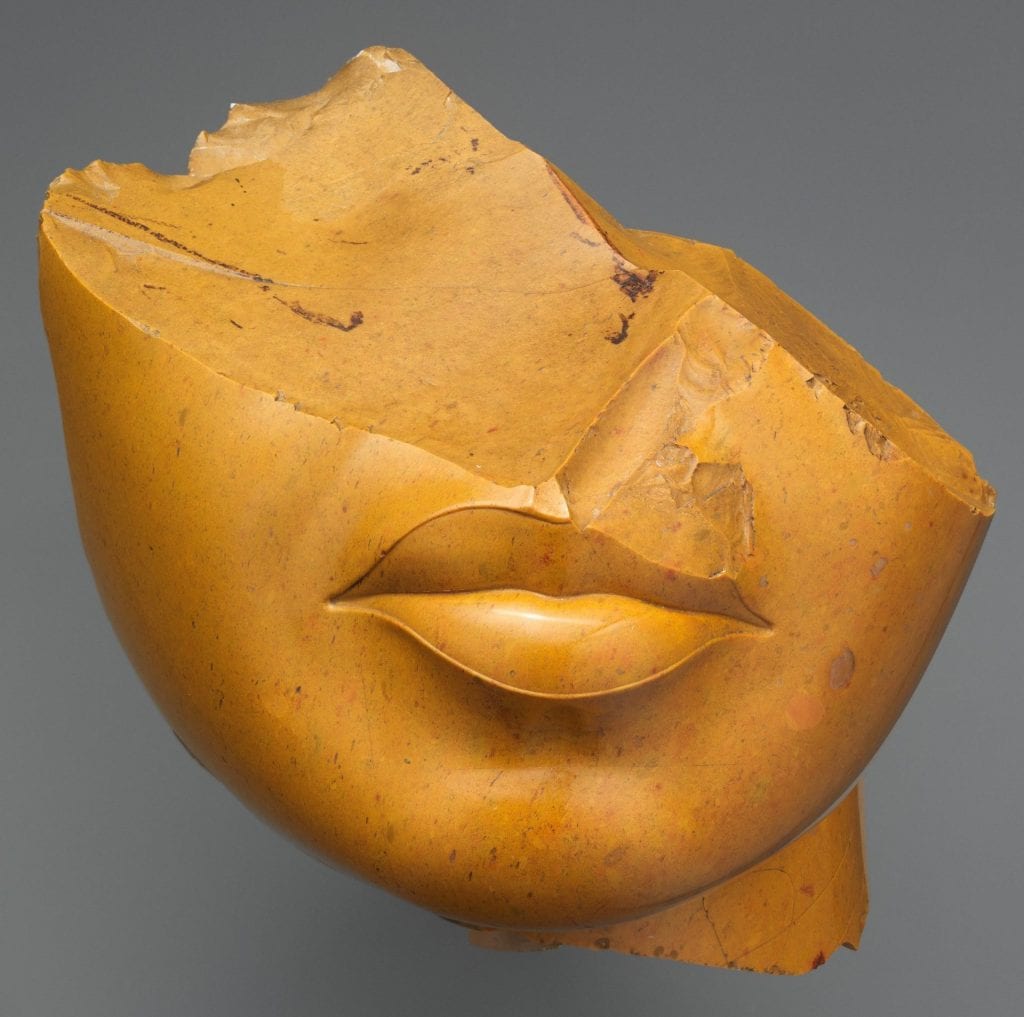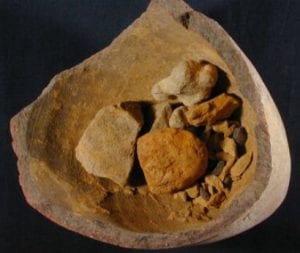Colours of Ancient Egypt – Yellow
By Anna Pokorska, on 20 February 2019
This is the fourth post in the Colours of Ancient Egypt series; here you can read the introduction, here all about the colour blue, and here about the colour red.
Due to its availability in several different forms and shades, yellow was present in many aspects of ancient Egyptian art and decoration, from painting to pottery.
Just as men’s skin was painted red in Egyptian painting, women’s can be distinguished by its yellow colouring, which we can see in a fragment of a statue made out of yellow jasper possibly depicting Queen Nefertiti or Queen Kiya and dated ca.1353–1336 BC.

Fragmentary head of a Queen in yellow jasper, from the 18th Dynasty (Metropolitan Museum of Art, NY).
Yellow was also used to mimic gold in works where the use of the precious metal wasn’t possible. The most prevalent yellow pigments in ancient Egypt were derived from natural ochres and had the same properties as their red equivalents — but they were by no means the only source of the colour.

Painted linen mummy shroud painted with red lead, carbon black, orpiment and Egyptian blue pigments (Petrie Museum, UC38058).
Orpiment was a common yellow pigment with a rich lemon or canary yellow shade. It is an arsenic sulphide and occurs naturally in small deposits as a product of hydrothermal veins, hot spring deposits and volcanic sublimation, although nowadays it can be easily obtained artificially. The arsenic content makes it highly toxic and the sulphur will darken lead-based pigments if used together in a mixture.
Closely related to — although not as widespread as — orpiment is an orange pigment called realgar which can often be found in the same deposits. Despite its toxicity, it was the only orange pigment available until chrome yellows and oranges were introduced in the beginning of the 19th century. An interesting feature of realgar is that prolonged light exposure turns it into a yellow compound called pararealgar without changing its elemental composition.
In addition, Egyptians were able to synthetically produce a highly toxic lead (II) antimonate, also known as Naples yellow. It was often used as an enamel colour from about 1500BC, although it didn’t appear in painting until the Renaissance. As one of the oldest produced artificial pigments it was highly toxic and provided a warm orange shade of yellow. Interestingly, a mineral of the same chemical composition, called bindheimite, exists in nature but wasn’t used to create the pigment. Instead it was made by a calcination of a lead compound (such as lead white) with an antimony compound (e.g. potassium antimonate). A 19th century recipe recommends mixing the ingredients, placing them over a gentle heat and then gradually increasing the temperature. After approx. 5 hrs the calcination is complete, and the resulting product can be ground in water with an ivory spatula (because iron can react with the powder and change its colour). The shade of the pigment could also be manipulated by changing the proportions of the ingredients. Lead antimonate is very stable to light exposure but due to the lead content will turn black on contact with hydrogen sulphide (e.g. in air).
Why were so many dangerous substances used as pigments for so long, especially as harmless clays were so abundant? Although their toxic effects were known, the depth and brilliance of the lead and arsenic compounds made the natural iron oxides appear rather dull and brownish in colour by comparison. In fact, even the pigments that strove to replace them — cadmium, chromium and cobalt yellows which appeared during the 19th century — are all harmful to some extent, and it wasn’t until the development of organic pigments (based on carbon and hydrogen) that we overcame this issue!
 Close
Close



